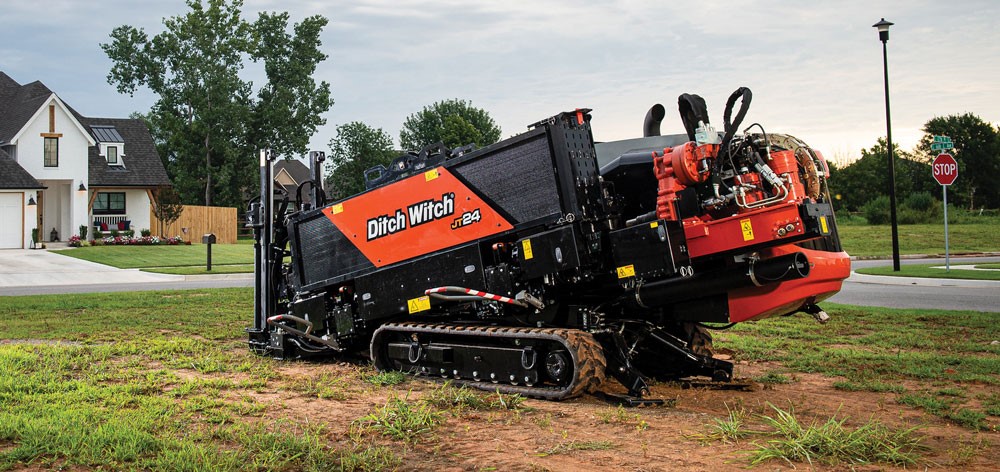HDD and Fiber Installations in the COVID Era

Work from home. Remote learning. Video conferencing with family, friends and even health professionals. Online entertainment, such as gaming, movies and music. Smartphones, laptops and tablets.
You name it, it’s being used in 2020 in record numbers and times — in many cases, our lifelines to the world outside of our homes. In a nutshell, our new normal.
But even before the onset of the COVID-19 pandemic, what aspect of our lives in the last decade or so hasn’t relied on bandwidth and high-speed internet connections? As this current health crisis surges forward in the coming months and into 2021, more and more reliance on our devices for work, school and family connections surges with it.
More bandwidth and faster upload speeds — this is what is being demanded. None of that talk surprises the fiber broadband community; the urgent need that pandemic caused was the surprise. They and the horizontal directional drilling (HDD) community are ready to meet that challenge.
Pre-COVID, the fiber broadband market was thriving as people craved more bandwidth and faster upload speeds for normal everyday life. Today, fiber broadband officials are projecting record numbers of installations needed to meet this demand now and in the future.
“Before the pandemic, fiber broadband was a booming business …Total fiber deployment is at record levels,” says Lisa R. Youngers, president and CEO of the Fiber Broadband Association. “For those who have [fiber-to-the-home] connectivity, fiber broadband has become a literal lifeline for telemedicine and a metaphorical one for work, school, entertainment and interpersonal connection.
“The pandemic has made broadband more important than we ever thought possible. The Fiber Broadband Association will continue our mission to accelerate the deployment of all-fiber access networks,” she says.
Youngers shares that fiber now passes nearly 60 million homes and connects 23.8 million people in North America. In the United States, fiber broadband now passes 46.5 million unique homes — about 37 percent of total — and connects 20.5 million. “Since March, researchers estimate that we have seen a 20 to 40 percent increase in the use of home broadband — and many of these uses are high-bandwidth applications like video conferencing.”
HDD and the fiber-optic market have gone hand-in-hand for more than 20 years, installing thousands of feet of fiber to connect our homes and businesses to that high-speed connection. In a pre-COVID world, the fiber-to-the-home (FTTH) market was a key driver for many HDD manufacturers and contractors as fiber buildouts rolled out during the late 1990s and early 2000s. As the oil and gas markets slowed in recent years, the fiber market boosted and stabilized the HDD market and industry experts believe this to continue.
“The late months of 2019 and the early months of 2020 continued the push for broadband, especially 5G, across the country and spurred an increase in the demand for fiber installation and HDD,” says Tucker Dotson, director of sales at Ditch Witch, as well as a board member for the Fiber Broadband Association. “During the months of March and April, when the industry as dealing with the height of the pandemic, there were a few project delays to ensure operator safety. However, the number of people working from home has increased, and so will the need for reliable broadband. Now, we are seeing equipment purchases rebound to similar levels as before the pandemic.”
Dotson see the increased demand for FTTH to be a critical driver the HDD market in the months and years to come as more people work from home and many regions turn to distance learning, putting additional stress on existing usage and high-speed internet limitations. This increase installations will place even more emphasis on the need for qualified HDD operators. “The work for HDD contractors in the broadband space will only continue,” Dotson says. “With that large demand for work will also come a need for more skilled workers.”
John Fluharty is chair of the Power & Communications Contractors Association (PCCA) and a longtime member of the HDD contracting community, having previously owned Mears. He helped to install fiber buildouts during the late 1990s while with Mears. He describes the fiber broadband market to be as strong as it has ever been and pushing forward to meet the exponentially growing need of FTTH. He, too, believes HDD will continue to be a key asset to the FTTH movement.
“Everybody you talk to, we talked about fiber availability, which means you are outstripping the capacity of what the industry normally made [pre-COVID],” Fluharty says. “We weren’t running out of material but we were making sure we had all of our ducks in a row because we were running that strong of market at the time. Obviously since the [pandemic], we are absolutely overwhelmed with opportunity.”
Fluharty strongly believes in fiber broadband and that it is the key to the speed that users want and need — especially during this pandemic as everyone and their multiple devices are in use every day.” We strongly believe that fiber is the solution to the speed problem,” he says. “The onslaught of devices being added to your home require more and more speed and without fiber, you’re not going to have the opportunity to expand the electronics to make it work.”
And HDD is once again front and center when it comes to installing these critical fiber buildouts. “HDD is as big a component as it’s ever been as far as the amount of feet installed,” Fluharty says. “You have a lot of utility contractors who self-perform and will continue to add to their rig fleet because they’ll continue to have more footage.”

He also notes that HDD manufacturers have been gearing their new products to the fiber market and will continue to do so. “You’re going to see more and more,” Fluharty says. “I think they have been gearing up in these markets for a long time.”
And HDD can take full advantage of this opportunity — as long as contractors play by the One-Call rules and avoid any highly publicized accidents. That’s the only thing that can stall the HDD momentum of acceptance, Fluharty says. “I’m the excavator representative for the [Common Ground Alliance] and on its board of directors. If you look back over the last 18 months, we’ve had some very high-profile incidents and almost all of them tied to fiber installation projects where they hit a gas line. PCCA has made a very strong stand on this issue. We think everybody needs to belong to One-Call and One-Calls have to be located accurately.
“Contractors have to pothole to know where these utilities are and people need to be held responsible to the fullest extent of the law of these situations or we are going to lose this opportunity to drill,” he says.
RELATED: John Fluharty, PCCA chair, joins the Trenchless Technology Podcast to discuss the impact of the COVID-19 pandemic on fiber installations.
Youngers says the importance of fiber broadband in this pandemic world cannot be overstated. The connectivity demands are not going away and will only increase. “We need fiber broadband networks to meet the connectivity demands of the COVID world,” Youngers says. “Video conferencing and other two-dimensional technologies require strong upload capabilities. At the beginning of the pandemic, for example, Virginia-based fiber broadband provider LUMOS Networks reported a 47 percent increase in upload traffic. And upload is where older networks struggle…Wireless and satellite cannot keep up and some cable networks can only manage one or two megabits of upstream. What we need are symmetrical networks and strong upstream capabilities — and all of that means fiber.
“To make this happen, we need to deploy more fiber and particularly rural fiber, thought both public and private investment,” she adds.
The cost for all of this is steep. Youngers says that research that the Fiber Broadband Association conducted in 2019 found that, by 2029, fiber can reach 90 percent of U.S. households by increasing current spending on all-fiber networks by approximately $70 billion. “A number of federal agencies have programs aimed to build-out our networks,” she says. “Most recently, the FCC launched a $20.4 billion Rural Digital Opportunity Fund, which will raise the bar for rural broadband deployment by making more areas eligible for support and requiring faster service.”
Fluharty notes that the pandemic has shown a glaring need for more fiber, as families and businesses are realizing they just don’t have what they need. “Finding out there are schools and [kids] who can’t do online school because they don’t have a connection,” he says. “We’re also finding out that some systems work well for one person [in the home,] but not when there are more than one using it. The head count of devices is so important.”
“Additionally, with many companies and individuals, choosing to continue operating in a remote fashion, reliable, high-speed internet is more important than ever,” Dotson says. “Whether it’s being used for business, school, telehealth or just the ability to communicate with friends and family, the fiber installation market will continue to increase.”

